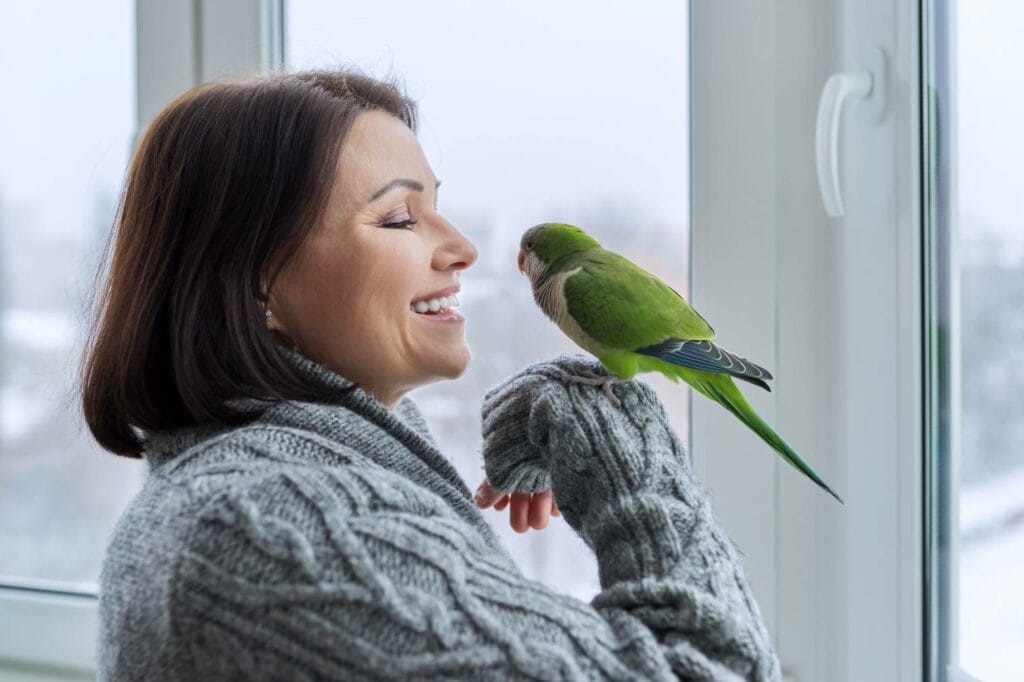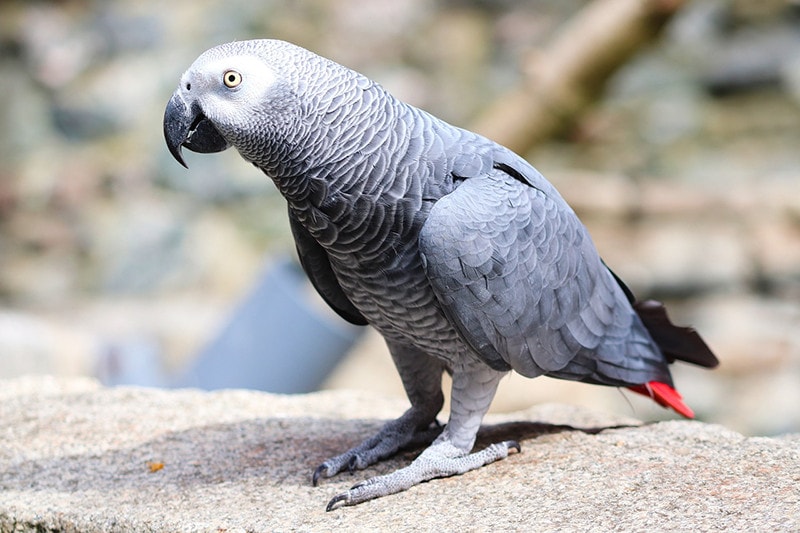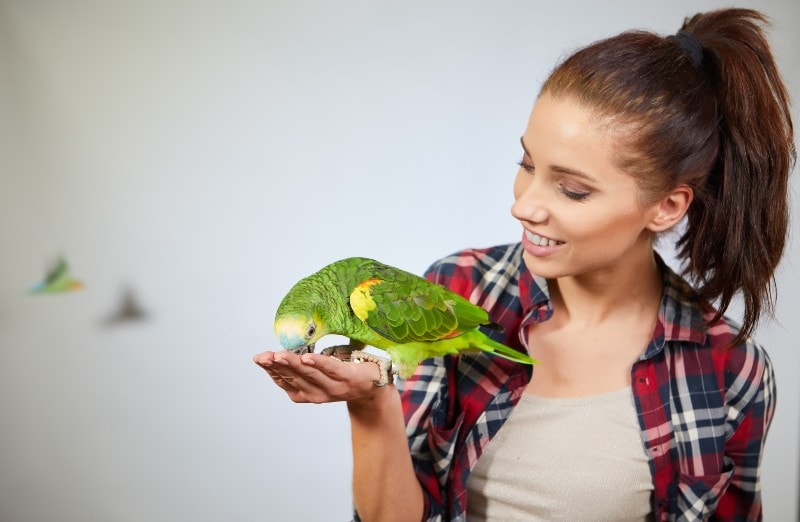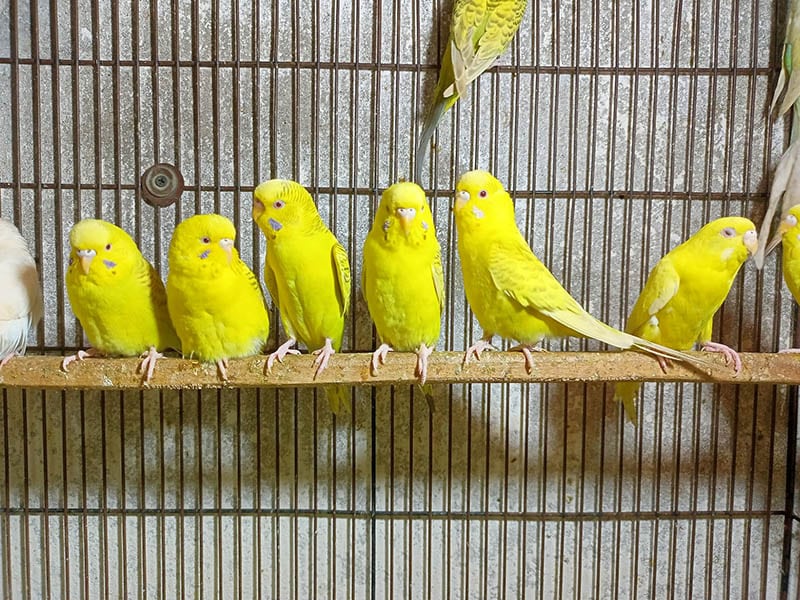Can Parrots Understand the Human Language? Vet-Reviewed Science & Info
By Oliver Jones
Updated on

Everybody knows animals communicate with humans to some extent, but we rarely expect the pleasure of a full-blown dialogue with our pets. Among all birds, parrots are some of the most clever and articulate, capable of crude conversation that often verges on the impossible.
Beyond their sound, how deep does their comprehension of spoken words go? Can parrots understand English? Are they communicating, or are they mindlessly mimicking? The answer may be surprising, but it’s not necessarily straightforward. Parrots can communicate with you but not always in a conversation. If you’re wondering whether you and your pet bird can have a quality conversation, we’ll explore how much parrots understand human language.
Why Do Parrots Talk?
Parrots are talented mimics. Other feathered mimics include mynah birds, mockingbirds, ravens, and the lyre bird. They imitate the sounds they hear, creating various noises ranging from clear English words to glasses clinking or cats meowing.
As social animals, parrots strive to communicate with their neighbors to work and survive together. They are one of a handful of animals (including humans and whales) born not knowing a language. Unlike your family dog, which came into the world with their species’ language template in place, your parrot has nothing but the capacity to learn.
In the wild, parrots adopt the language of the animals around them. As this can change significantly from one environment to the next, the “dialect” of one group of parrots can be different than that of another, like the differences in human language.
A parrot in captivity will adjust to the language of their environment. Your dog will always speak “dog,” regardless of upbringing or location, but your parrot will only speak your language.

Can Parrots Understand the Human Language?
Parrots develop a human language out of necessity, but their understanding typically ranges around that of a child 2–3 years old. They lack the ability to grasp complex concepts common to how we speak. Compared to other vocal learners, their advanced song system makes them superior mimics. Accompanying the limited vocabulary, they display numerous non-verbal actions to expand their communicative range.
With a relatively childish grasp of language, parrots mimic words they know based on context. In a conditioned way, they might say “hello” when you walk into the room. Your parrot knows they may get a favorable response without understanding the word’s meaning. They hear us talk, and when they land on a word we recognize, they see that it gets a reaction from us and make it part of their lexicon to gain attention and form bonds with their flock.
Parrots Can Communicate With Language
Parrots come with natural talent, but how well they can talk is up to the owner. Given their intelligence, parrots with casual owners will still pick up on context clues and build a few dozen words into their vocabulary. Most have a firm understanding of the proper time to vocalize certain words. With focused training, they can show their full potential, even to the point of understanding the ideas behind words.
African Gray Parrots and Human Language
Studies on the African gray parrot (Psittacus erithacus) have singled it out as one of the most adept language learners. Animal psychologist Irene Pepperberg bought a 1-year-old gray parrot named Alex in 1977 and made him the focus of a decades-long experiment on the parrot’s intelligence. Under Pepperberg’s guidance, Alex developed a long list of verbal skills transcending everyday mimicking, including:
- Labeling over 50 unique objects
- Identifying seven colors and five shapes
- Understanding categories, quantities, and comparison words
- Recognizing and counting numbers up to eight
- Understanding a concept of “zero”
Alex could create and decide when to use simple phrases. In possibly the only instance of an animal asking an unprompted existential question, Alex asked about his color before learning the concept of “gray.” Proving a legitimate grasp of human language, he understood words as ideas rather than arbitrary sounds connected to a stimulus or response.
Pepperberg and collaborating scientists further examined the cognitive abilities of African gray parrots through a series of intelligence tests. Their subject, Griffin, performed increasingly difficult reasoning tasks, displaying complex logic even beyond that of an average 5-year-old. With that level of insight, their ability to comprehend the symbolism behind human language doesn’t sound too far-fetched!

How Do Parrots Talk?
Unlike people, parrots don’t have vocal cords to create noise. Instead, they utilize a pair of muscles called the syrinx at the trachea’s base. The syrinx produces sounds when air passes over its muscles. Because the syrinx is found after the trachea splits into two branches (known as bronchi), parrots and many other birds can produce different sounds from each “side” simultaneously. This allows them to make complex vocalizations (for example, they may be humming from one side and producing a whistling sound from the other side simultaneously).
How Many Words Can a Parrot Learn?
Parrots can typically learn 50–100 words. The current record-holder for the broadest vocabulary is a budgerigar (popularly known as a parakeet in some parts of the world) named Puck. Puck passed away in 1994, but not before learning a remarkable 1,728 words! Though they haven’t quite reached Puck’s status, African gray parrots often expand their vocabularies to include up to 1,000 words.
Teaching Your Parrot to Talk
Parrots in captivity will take on the sounds of the people and animals in their environment for rudimentary communication. Although it may take expert animal behaviorists to train birds at Alex’s level, you can promote impressive language development at home by following basic principles.

Using Rewards and Showing More Emotion
Emphasis and rewards are meaningful to parrots. If the actual symbol of the word flies over their head, an association can inspire them to use certain words and phrases. Emotion in the voice is one example, which might explain why parrots easily pick up profanity. They can also see what elicits a response to learn which words to repeat, which is another reason they may curse.
Speaking to your parrot in an engaging, upbeat voice and offering rewards like affection and treats can create those relationships between the words and things they find pleasing. Showy movements and exaggerated speaking tones add excitement that makes them more likely to talk. While you’re away, you can continue teaching your parrot to speak by letting them watch TV or listen to audio recordings of your voice.
Consistency
Training a parrot to talk is primarily dependent on consistency. It’s best to repeat words and phrases often and in appropriate contexts. Explain what you are doing, ask questions, and look for intriguing ways to communicate with your parrot.
Final Thoughts
With a little effort, a parrot can convincingly communicate with you. While you may not reminisce or make plans for the future, you can take delight in the present through teaching new words and engaging in daily chats. Researchers are still far from knowing just how much parrots can understand human language, and in the home, pet parents can look forward to plenty of exciting surprises.
See Also:
Featured Image Credit: VH-studio, Shutterstock












